GUT Visiting Artist: Gretchen Rubin
How paying attention to our senses can boost creativity and happiness
Welcome to the DrawTogether Grown-Ups Table! New here? Check out the introductions and say hi. Been at the table a while? Pop back over to see who has joined and welcome the newest GUT members. Want to become part of the GUT community, share artwork, support one another, do IRL meet-ups and other fun stuff? That happens in the GUT members-only chat. Questions about the GUT? Drop ‘em in the comments. So, so happy you’re here! xo,wm
Helloooooo GUT fam!
Quickly, I gotta say: I’ve been in NY this week and was lucky to catch the Ruth Asawa drawing show “Through Line” at the Whitney. In the area? GO! Nowhere near? I got you. I was so inspired by show’s deep dive into Asawa’s drawing habit (addiction!), that next week I’ll give you my take on the show, show some of my favorite, unexpected pieces from exhibition, and share what I think we can all learn from her life and drawing practice.
This week, we are lucky as all get out to have a special visiting artist/author with us.
What the heck is a GUT Visiting Artist?
For folks new to the GUT, every month or so I invite a very special artist/illustrator/author/creative type to be a GUT visiting artist. In the visit, I share a little about their work and why it inspires me, do an interview with them, and then they give us our drawing assignment for the week based on something they’re interested in. It’s a fun way to be exposed to different kinds of creative folks, and learn about varied artists processes and perspectives. Previous GUT Visiting Artists have included Maira Kalman, Julia Rothman, Tucker Nichols, Lena Wolff, and collage artist Ariel Aberg-Riger.
And I’m so excited for our newest visiting artist. She is a world renowned author whose work intersects with creativity and all we do here on the GUT in such a unique and important way. I think we’ll going to learn a lot from her this week - in our convo, in our Instagram Live conversation, and with this week’s drawing assignment.
Drum roll please….
Visiting Artist: Gretchen Rubin
Creativity boosts our mood and our energy. It gives us a sense of accomplishment. It helps us communicate our vision to the world. It often helps us deepen social connections. - Gretchen Rubin
I remember vividly where I was the first time I learned about Gretchen Rubin. It was about 14 years ago. I standing in my closet putting away clothes when something on NPR grabbed my attention. A woman was being interviewed about all these things she did over the course of a year to help herself feel happier, and she was telling stories and offering tips based on everything she’d learned and put into a book for others to benefit from. She was like human happiness guinea pig.
Now, this was long before 100-day projects and self-care experiments took over the planet, and the idea of a person putting themselves through a sort of scientific experiment to change their mental sat was, to me, totally novel. It combined combined cool headed research and open minded creativity - and she’d put herself in the hot seat. It was admirable, impressive and sort of astounding, while at the same time totally light-hearted, fun and accessible.
I loved it.
That author was Gretchen Rubin. The book was The Happiness Project. As of a few years ago The Happiness Project has sold over 2 million copies, and helped countless people make little shifts in their lives that made big impacts on their happiness. She has inspired readers around the world to push outside their daily habits and try something new.
Since that literary explosion, Gretchen has written two more books - most recently Life in Five Senses. While Gretchen might use words as her medium, her approach to her work (and life) is similar to how we use drawing here at the Grown-Ups Table. Her work inspires people to approach the world with fresh eyes, experiment and tinker with new approaches, and see how those experiences change us, inside and out.
So it is with a huge bow that we welcome Gretchen Rubin to the GUT this week as our newest visiting artist.
I had a delightful (happy-making!) conversation with Gretchen about the intersection between creativity and happiness, and how focusing on our senses can impact our day to day life. Gretchen also draws on her research and personal experience to offer us our drawing assignment this week. And don’t forget, Gretchen and I will be doing an Instagram LIVE together on Monday October 30 at 5pm PST. Just head to Instagram.com/wendymac. Bring questions!
And without further ado, I present you (drum roll…) GUT Visiting Artist: Gretchen Rubin.

In Conversation with Gretchen Rubin
Wendy: Hi Gretchen, and thanks for hanging with us at the Grown-Ups Table this week. Many people know your work from your NYT-bestselling book The Happiness Project—the book documenting your 12-month journey trying different approaches to feel happier. You’ve also just published a book called Life in Five Senses, in which you dive deep into the world of the senses to become more present and attuned and happier in your life. In these endeavors and others, you’ve researched how creativity intersects with happiness. What links have you found between creativity and happiness?
Gretchen: There are so many links between creativity and happiness!
Creativity boosts our mood and our energy. It gives us a sense of accomplishment. It helps us communicate our vision to the world. It often helps us deepen social connections. It gives us the atmosphere of growth that’s so key to happiness—the feeling that we’re growing, learning, and pushing ourselves in an exciting way.
And creativity is fun—even though, of course, it can also be frustrating (which is part of the fun). On the Happier with Gretchen Rubin podcast, we occasionally throw out a creative prompt such as “Choose a one-word theme for the year,” “Identify your personal symbol,” or “Write a haiku.” Listeners always respond with tremendous enthusiasm.
Wendy: How does art and creativity play out in your daily life? Specifically, where do you get your creative inputs? What do you like to look at, listen to, or do that feels like an infusion of creativity?
Gretchen: I have a few key sources for creative inspiration.
Reading. Reading is my tree house and my cubicle, my work day and my snow day. Reading is how I get ideas, discover better or new ways to express myself, and get ideas for new projects. As I read, I’m always looking for passages that I want to note, and when I’ve finished reading a particular book, I type my notes into my computer. So as I’m reading, I’m writing, and I’m creating.
For instance, I had the idea to write The Happiness Project because my notes on happiness had become so vast that I thought, “Wow, I should write a book about my happiness project.”

Visiting the Met. As research for my book Life in Five Senses, I decided to visit the Metropolitan Museum of Art every day for one year. (I’m incredibly fortunate: I live within walking distance of the Met, and have the time and freedom to visit.) That year is long over, and I still visit every day. I love to see how the Met changes over time, and how each of my senses reveals different aspects of it, and how making a daily visit changes me.
Looking at the Met’s masterpieces has given me countless ideas. For instance, for years I’d been collecting “indirect directions”—short, enigmatic prompts I used to give me sparks of inspiration when I felt creatively stuck. I was in the process of turning these indirect directions into an actual thing I could hold in my hand, but I couldn’t think of a good name for the project. Then, during a Met visit, as I looked at the elaborate maiolica Inkstand with Apollo and the Muses from 1584, I thought, “That’s the perfect thing for a writer: an inkstand covered with Muses.” That gave me the name for my own project: the Muse Machine. I’m so excited; I worked with a brilliant team to turn my messy DIY Muse Machine into an actual item to offer to other people.

Looking at the Met’s masterpieces has given me countless ideas.
Wendy: And what are your creative outputs? What do you do or create on the day-to-day that meets that human need to make something?
Gretchen: Long ago, I realized that to create my best work, I do better when I work consistently; pouring out ideas is better for my creativity than doling them out with a teaspoon. So I work every day—including weekends, holidays, and vacations. I get up at 6 a.m., and often 5 a.m., because I’m a morning person. For me, that practice works best.
I work on drafts for several book projects every day (some turn into actual books; some don’t). I create material for the weekly Happier podcast (I’m very vain about the fact that we’ve never taken a break in the eight years of the podcast). I write my “Little Happiers,” which are short essays about happiness that I post each week in the Happier feed. I write a weekly newsletter, called 5 Things Making Me Happier. I create material for the Happier app. And, of course, I read and take notes for various projects.
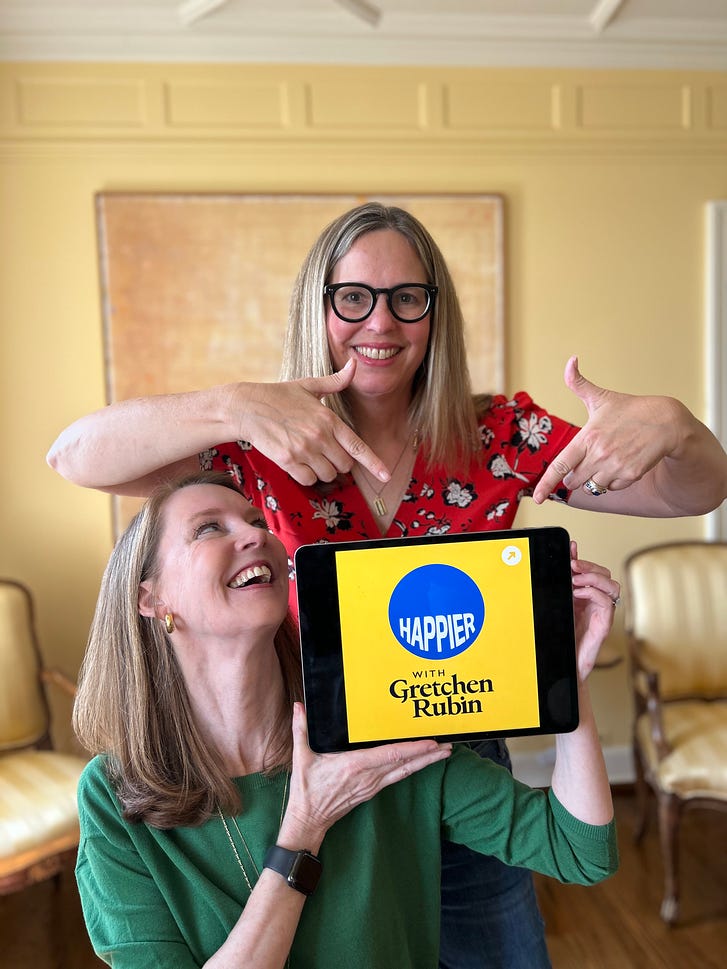
I also get a lot of ideas from talking to other people. Some of my biggest insights have come from an offhand remark from a casual acquaintance. Someone I didn’t know very well said to me, “When I was on the high-school track team, I never missed track practice. Why can’t I go running now?” Why not? Her remark eventually led to my “Four Tendencies” personality framework. So I try to do a lot of listening.
I realized that to create my best work, I do better when I work consistently; pouring out ideas is better for my creativity than doling them out with a teaspoon.
Wendy: What challenges get in the way of incorporating creative input and outputs into your daily life, and how do you move through them? In other words, what do you do when you get stuck?
Gretchen: Gretchen: I’ve realized that to keep going, I need to allow myself to stop. I make sure to schedule time to goof off (as ridiculous as that may sound). For instance, going to the Met is one way to make sure I have time to wander. I’m also a big fan of the short mid-day nap.
If I get stuck, I go for a long walk in Central Park. I talk to people and call my sister. I allow myself to read or re-read at whim and take notes on anything that catches my interest.
Those strategies always work for me.
I’ve realized that to keep going, I need to allow myself to stop.
Wendy: Let’s turn towards the senses, because so much of getting into a creative project is about being present. And I find one of the best ways to get present is to attune to our senses. In your research, have you found any helpful information on how we can use our senses to get more in touch with our creative selves?
Gretchen: Absolutely! And I discovered a great exercise to harness our senses to spark creativity: Keep a daily five-senses journal. On a piece of paper, write down “Seeing,” “Hearing,” “Smelling,” Tasting,” and “Touching,” and every day, write down one notable experience from each sense that day. It’s astonishing how this exercise sparks memories, gives ideas for new adventures, helps us to connect with others, and gives us ideas for creative projects. It also heightens our awareness of the present moment and acts as a gratitude journal.
For me, noting the fun of doing a taste comparison inspired me to throw a “Tastes Party” for my friends, where we compared the tastes of varieties of apples, chocolate, potato chips, and more.
I loved keeping a five-senses journal so much, and found it so useful, that I created an actual Five-Senses Journal that’s beautifully designed, and includes other creative prompts, such as the “five-senses portrait.” I love keeping this journal (which also has the advantage of being very quick to do, even though it’s so useful).

When I started my research, I predicted that tuning into my five senses would spark my creativity—and wow, that has happened. To be honest, I’m a bit overwhelmed by how many more projects I’m working on or planning.
Wendy: How does community and playing with others fit into your findings around creativity, happiness, and embracing the senses?
Gretchen: Being with other people is often a great way to spark ideas and create a sense of play, whether by riffing on ideas, learning and teaching techniques, sharing constructive criticism, or just goofing around. For instance, I did two major photo projects with one of my best friends. These projects took so much time and energy, and I love them so much. This kind of project was so different from the usual kind of thing I do that I found it extraordinarily energizing.
Being with other people is often a great way to spark ideas and create a sense of play, whether by riffing on ideas, learning and teaching techniques, sharing constructive criticism, or just goofing around.
Wendy: Last but not least, we ask our visiting artists to offer a drawing assignment to GUT members. Would you give us our drawing assignment this week?
Gretchen: I’m excited to share an exercise with you that I call the Five-Senses Portrait—something I developed while researching my book Life in Five Senses. Typically, this has been a written exercise, but given that GUT is all about drawing, I’ve turned it into an art assignment that can help bring our sensory memories to life
Assignment: Five-Senses Portrait
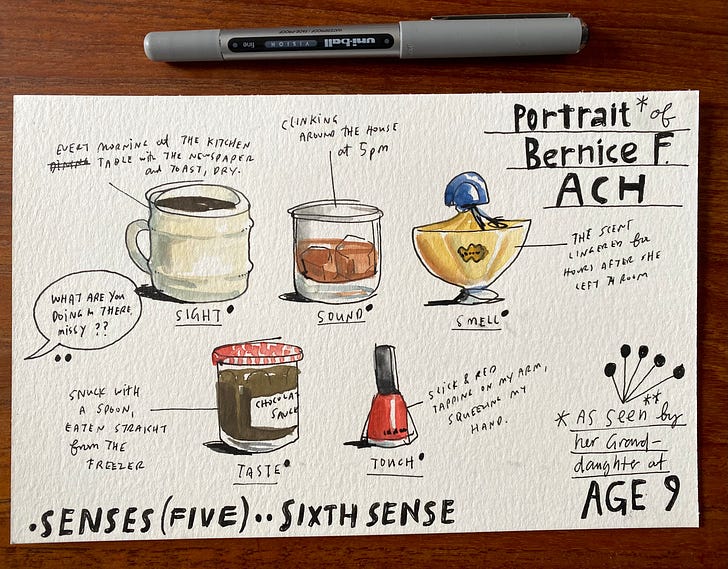
Step 1: Choose Your Subject
It could be anyone or anything that holds a special place in your heart. Person, place, experience, trip, pet.
Step 2. Write Your Five-Senses Portrait
Write down five associations for each of the five senses: sight, hearing, smell, taste, and touch. Take your time. Let each memory and association fill your thoughts, creating a vivid sensory portrait of your chosen subject.
When I did this for my husband Jamie, crafting that portrait helped me to focus on the concrete reality of his presence and also on my favorite memories of him; it helped me to appreciate both the present and the past.

Step 3: Pick Elements for Your Drawing
Now, with your written portrait, pick a couple of the strongest sensory elements that stand out to you. These specific details, rich in sensory information, will serve as the base for your drawing. It could be the texture of a favorite sweater and the aroma of freshly baked cookies—whatever evokes the strongest emotions and memories.
Step 4: Bring Your Sensory Memories to Life
Draw those elements in whatever you want. They can be realistic, abstract, a chart or diagram—but no matter how you draw, this is not about doing a realistic or “perfect” drawing (I know you all in the GUT don’t do perfect, anyway); this is about using drawing to focus on expressing the sensory details to really sink into the importance of your chosen subject.
Step 5: Share Your Drawings in the GUT Chat!
Share your Five-Senses Portraits in the GUT CHAT! I can’t wait to see what you create. Wendy and I will select a few from there to share on our social media and during our Instagram Live conversation.
Such a great visit. Thank you, Gretchen!
So excited for this one, y’all.
I’m posting a chat today where we can share our Five-Senses Portrait with one another (and Gretchen!) and then we’ll look forward to seeing you on the Instagram live on the 30th at 5pm PST!
Love to hear your reflections on the discussion with Gretchen - leave your thoughts in the comments below.
Have a great week, all! See you in the chat! <3
Everything is better….
w
PS - DrawTogether Strangers Pop-ups Around the WORLD!!! Big love to everyone who hosted a DrawTogether Strangers pop-up in public or in the privacy of their own home. Drawing is looking and looking and loving!
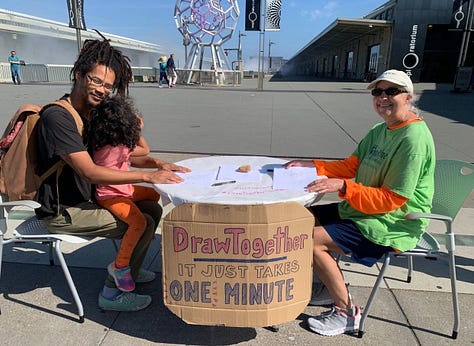
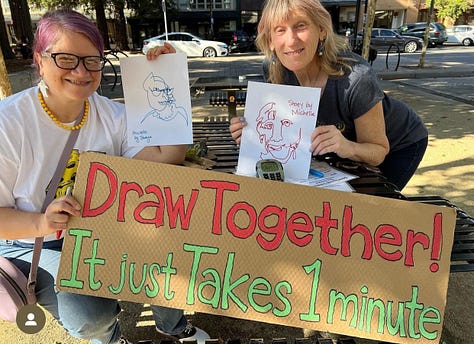



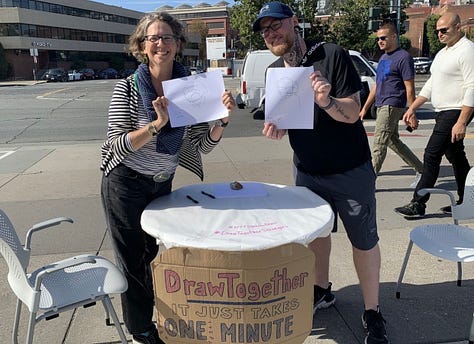



What a brilliant collaboration! Gretchen is a legend and I love her advice here to help us stay present. Thank you for bringing this into our Substack world! Looking forward to your live chat on the 30th! 😄
I've been having a hard time writing in the last few years, so I recently turned to all my fabric and yarn and just played with it. It's surprising what I've ended up making—nothing useful, or wearable—it's all just playing with colors and textures, how it feels in my hands, how the colors look together. It's kind of blowing my mind, and now I'm definitely trying this five senses exercise.